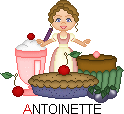|

Patat (Fries): The Dutch eat fries with mayonnaise. It's called "Patat Met" (Fries With). Fries with mayonnaise, ketchup and chopped onions is called "Patatje Special" (Fries Special) and fries with mayonnaise, peanutsauce, currysauce and onions is called "Patatje Oorlog" (Fries at War *s*).

Genever: In Dutch, this word means juniper, and is used to describe Holland's gin because juniper is one of the principal ingredients with which it is flavoured.
Dutch gin is supposed to be drunk straight and icy cold. The flavour of Dutch gin is stronger than that of the London dry style, and it has a fuller bouquet. It is heavy-bodied and strongly flavoured with a malty taste and aroma. Not well suited for mixing.
Genever gin dates back to the mid 17th century and was invented for a specific purpose by a single individual--Dr. Franciscus de la Boe (1614-1672), also known as Dr. Sylvius. Dr Sylvius was a professor of medicine at Holland's famous University of Leyden. He was looking for an inexpensive, but effective diuretic to use in the treatment of kidney disorders. Soon many Dutchmen considered this purifying tonic necessary for their good health.
The English King William III, who was born and raised in Holland, introduced genever to England. British troops abbreviated the word genever to gin when they first tried the drink while fighting in Holland in the 17th century. In
the 18th century, Queen Anne helped the British gin industry by raising import taxes on foreign wines and spirits and lowering taxes on British spirits. The taste of English gin suited the British people, and they soon made it England's national drink.

Bruidstranen (Bridal tears): It is a very old custom to serve a glass of bridal tears at a
wedding-party. The silver tears (tranen = old Dutch for drops) symbolise the bride, the gold leaf symbolise marriage.
The liquer consists of seeds, spices, curaçao-apples and real gold leaf and silver leaf.

Beschuit met muisjes (Dutch rusk with aniseeds): It is a Dutch birth custom to serve all the visitors who come to meet the newborn baby the so-called "beschuit met muisjes". "Beschuit" is Dutch rusk and "muisjes" (literally: little mice) are little aniseeds covered with a thin layer of sugar: in case of a boy they're blue and white, and in case of a girl they're of course pink and white. The father will also treat his colleagues to "beschuit met muisjes".




|